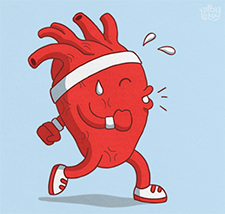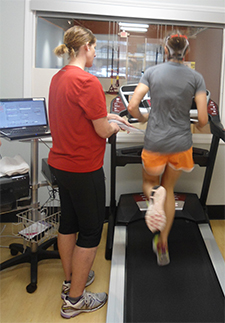Let's Get to the Heart of the Matter
Though we all come to the sport of running for different reasons, we are all branches on the same family tree, so to speak. And even though we’re not all striving for the same goals, we have more in common than we may realize. Besides the obvious lacing up of our shoes and setting out to put one foot in front of the other, we have something else in common:  we all want to improve our cardiovascular systems.
we all want to improve our cardiovascular systems.
What? Try to improve my cardiovascular system? you may be thinking. Yep. Although your goal may not include that exact statement, your heart is at the heart of the matter. Whether you want to run faster, look better, or live healthier, improving your cardiovascular system is at the root of your goals. Why?
Your cardiovascular system is the engine that drives you. The intensity level at which you run has specific physiological responses. I like to equate training heart rate zones with lifting: just like every lift has a specific adaptation, every heart rate zone has a specific adaptation as well. If you want to build bigger arms, then you need to focus on the lifts that develop that adaptation. If you want to focus on fat burning, you need to focus on the heart rate zone that develops that adaptation. To properly reach your goals, you need to incorporate the correct heart rate zone to give you the adaptation we want.
So how do you do that? It is both easy and hard to find heart rate zone information in books, magazines, and on the internet. Finding information is easy; wading though the information overload is a confusing headache. One expert might promote a three heart rate zone model, while another, equally qualified expert will explain how his ten heart rate zone model is best. Once you wrap your brain around the number of zones, then you must look at the percentages associated with those zones. Then you need to find your own personal zones and percentages. It can be an extremely confusing endeavor for even an experienced runner.
Let’s start at the beginning: finding the proper heart rate to use as a basis for each zone. The old standard “220 minus your age” to find your maximum heart rate is about as accurate as a dartboard and a dart. A simple formula simply cannot accommodate everyone’s vastly differing physiologies. The most accurate way to find your specific heart rate zones is a  VO2 Max test. There are other self-tests you can perform; you can also estimate your zones with the assistance of a coach. Our Be A Better Runner program utilizes these tests and teaches you how to incorporate heart rate zones into your training. One of my favorite tests is the talk test: the point at which you need to take even the slightest breath (or pause) when saying the Pledge of Allegiance fairly accurate correlates with your anaerobic threshold.
VO2 Max test. There are other self-tests you can perform; you can also estimate your zones with the assistance of a coach. Our Be A Better Runner program utilizes these tests and teaches you how to incorporate heart rate zones into your training. One of my favorite tests is the talk test: the point at which you need to take even the slightest breath (or pause) when saying the Pledge of Allegiance fairly accurate correlates with your anaerobic threshold.
Once you have a basis for your heart rate zones, you need to figure out each zone’s intensity level. This is where percentages come into play. However, because each of us has trained differently throughout our lives, we each have different physiologies. That means that even though you may be doing the same training as your best friend, you have developed different aspects of your cardiovascular system according to your unique physiology. That means your zones may lean one way while your friend’s may lean another. A VO2 Max test is a great way to find out which areas you’ve trained well and which areas need improvement.
The percentages of your zones also goes hand-in-hand with the number of zones you set up for yourself. Whether you use three zones or ten, the goal is to focus your training towards your specific goals. (Train smarter, not harder, right?)
Thus, you want to identify the intensity levels of your aerobic/oxidative energy system, your anaerobic threshold/oxidative/glycolytic energy system, and your anaerobic/glycolytic energy system. (Phew!) As a coach, I’m not concered with what number an energy system is given; I simply want to focus on the proper intensity level to help my athlete achieve his or her goals.
Remember that each zone has a specific adaptation. The aerobic energy system helps the body burn a greater percentage of fat while also developing more capillaries. Training at anaerobic threshold significantly improves aerobic capacity while also burning lots of calories. This is the area where most training is done when pursuing improved performance. Training anaerobically helps improve your speed, neuromuscular recruitment, and economy. However, spending too much time in this zone leads to overtraining. By mixing and matching these zones, you can develop an efficient and effective path to reaching your goals.
No matter what your goals are, learning to utilize the proper intensity levels can help you focus your training. Heart rate training can help cut out wasted time due to trial and error. Let FLEET FEET Training help you find your specific heart rate zones based on your physiology so you will be better equipped to achieve your dreams.
Good Luck and Happy Racing!
Coach Cary
Tim Cary is FLEET FEET's Assistant Training Manager, coach of the FLEET FEET-sponsored Runnababez Elite team, and manager of the FLEET FEET Racing Team. Over his 20 years of coaching, Tim has coached athletes to three national team championships, five national individual championships, two national records, and numerous All-American and All-State honors. Click here to receive Tim's weekly article via email.
Connect With Us
see the latest from Fleet Feet St. Louis